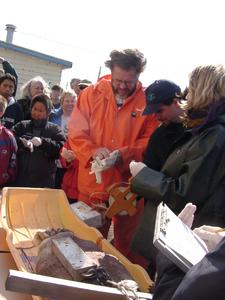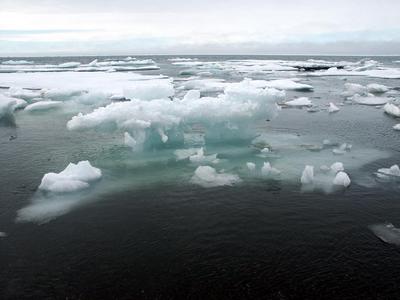
|
19 July, 2003Saturday 7 a.m. 44 degrees winds 18-22 mph, sunny and clear Check the Aerosonde Mission Diary for updates. The weather reports look good this morning. It is nice and clear, but the wind is still a bit strong. The team doesn’t like to take off and land if the wind speed is 15, so we will wait a few hours to see what happens. Everything looks good on the weather map, but the local wind is the problem. Wide-range weather maps do not always show local variations or microclimates. In the workshop, Siegfried and Clay are put through more pre-flight checks. Clay will carry the KT-11 and a digital camera on its short flight; its purpose will be sea surface measurements. Siegfried will carry an iridium cell phone and a digital camera and will record sea ice characteristics. The plan is to launch around lunchtime, depending upon the weather. While the crew is determining the COG for each airplane, I walked down to the beach. The wind is seems to be stronger, even though the weather station says it is steady at 12. Whitecaps are chopping the water; these are the first I have seen. It is still sunny and bright, and sea ice can be seen in the distance. It looks as if it is blowing towards shore. Small chunks of it are already along the waterline. We drove out to the runway hut to check the conditions there. The wind was now blowing straight down the runway at 18 – 22 mph, and Brett did not look happy. It would be his responsibility to manually control the aircraft, and the increasing wind speed was a concern. There was an incredible stench coming from a building close to the runway. An incinerator has been situated on an old navy dumping site. It was built to extract contaminants from the soil by using a special incineration process. It stinks, literally – like burned metal. I know that the soil must be cleaned, but I wonder how much contaminant was now being pumped into the air. There seems to be a lot of contaminated soil at this northern end of Barrow and beyond the NARL complex. Back when this was a naval petroleum/fueling/storage station, I guess that not much though was given to what was to be done with old oil, petroleum products, or other chemicals. “Out of sight, out of mind” was the prevailing mindset then (and still is today, in some places), and I suppose that little or no thought was given to where things went after they were buried in the soil or dumped into the ocean. In one form or another, these chemical ghosts are coming back to haunt us. The Aerosondes were ready to go, but this afternoon the decision was made to postpone until tomorrow. Despite clear skies and pleasant temperatures, the crosswinds on the runway were much too hazardous. Seal Guts Sea ice was up on the shore and scattered along the beach by this afternoon. The waves and surf were rough, so I decided to abandon the beach and attend a lecture at the UIC Science Center. A presentation about seals was to be given by a graduate student from the University of Alaska-Fairbanks Institute of Arctic Biology. These lectures are sponsored by BASC and the National Science Foundation’s Schoolyard Project. Bring scientists and teachers to share with the community. I was pleased to see that TEA Dave Brown has been scheduled to make an appearance next week! Dave’s group will be giving a program on July 24. Today’s lecture specifically addresses accumulation of heavy metals in seal tissues. The study investigated what the seals eat and where in the food chain the metals are concentrated. Researchers focused on two principle questions: How do these metals accumulate in seals, and does the age of the seal play a role in this process. Each question brought with it an obstacle. First, to find out how metals accumulate in seal tissues, researchers must know what seals eat and where they are getting their food. Secondly, if age is indeed a factor, researchers must have an accurate (or at least consistent) method for aging seals. Scientists must be able to analyze a seal’s stomach contents to determine what it has been eating. Today’s seal was donated by a local hunter. Cementum, a covering at root base of teeth, is a good age indicator for most mammals. The cementum layer is laid down each year and forms concentric rings around the root of the tooth. These layers look like tree rings, and like tree rings they give a good estimate of age for both Ringed and Bearded seals. For young seals, claw lines/ridges (lines on nails that are formed yearly – a type of growth ring) may be used as an age determiner. Claw lines are not accurate indicators for older animals as the seals probably wear their claws down because they are constantly scrambling over the ice. This is especially true for female Ringed seals, the only seal that makes dens over ice holes. Different species have different food preferences and feeding habits. Before comparing levels of contaminants in their tissues, it was important to determine exactly what seals eat and where they eat it. It has been found that bearded seals prefer to feed on the bottom of the ocean. They eat mollusks, shrimp, crabs, octopus, marine worms, and a small amount of fish. Ringed seals feed in the open water and sometimes on the bottom, and their food consists of mainly krill, arctic cod, and sand lance. The spotted seal feeds in open water and eats fish exclusively. Since seas differ in chemical content and, subsequently, food supply, it was important to find out where (the Beaufort Sea or the Chukchi Sea) the seal get most of their food. Carbon isotope ratios differ in the Chucki and Beaufort Seas. Scientists can determine the primary feeding area of a seal by comparing these ratios. Three heavy metals were investigated in the study: mercury, silver, cadmium, and silver. It was found that these metals concentrate in different parts of the food chain, and therefore are found in different species of seals depending upon what they (the seals) are eating. Bottom-dwelling invertebrates and some fish species tend to concentrate cadmium in their tissues. All of the bearded seals and some of the ringed seals had cadmium in their tissues. Since mercury is mainly concentrated in fish, it is not surprising that the spotted seal – the fish-eater – had evidence of mercury while the other two species did not. Silver collects in bottom-dwelling invertebrates; bearded seals had the highest amounts of silver in their tissues while ringed seals and spotted seals had less silver – about the same amount in each species – than bearded seals. This research is critical to understanding the health of our oceans and its inhabitants. The study clearly shows the effect of biomagnification of heavy metals in ocean ecosystems. The study also infers that humans are not immune to such problems. To find out more about seals and other marine species, go to the Alaska Fish and Game website. After the presentation, the audience went outside to examine a harvested ringed seal. Measurements of length, circumference, and weight were taken. The next goal was to collect and analyze the stomach contents. The children were very interested and were quick to don latex gloves and parcticipate in this unique “hands-on activity”. The day ended with a tour of Barrow. Glenn Sheehan, director of BASC took me on an historical and anthropological trip through time. In addition to explaining the layout of the town, he pointed out significant archeological sites. Now I can truthfully say that I have driven on the northern-most road in the US. What a treat!
Contact the TEA in the field at . If you cannot connect through your browser, copy the TEA's e-mail address in the "To:" line of your favorite e-mail package. |






